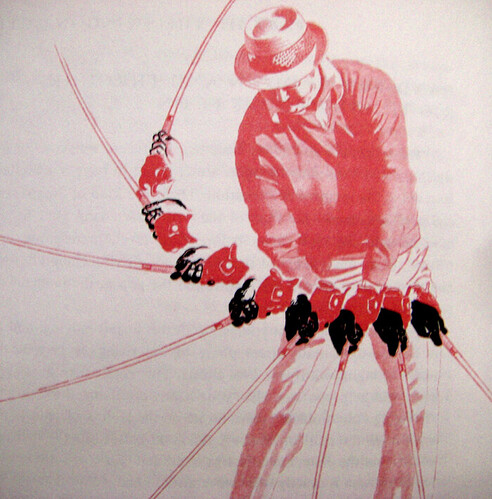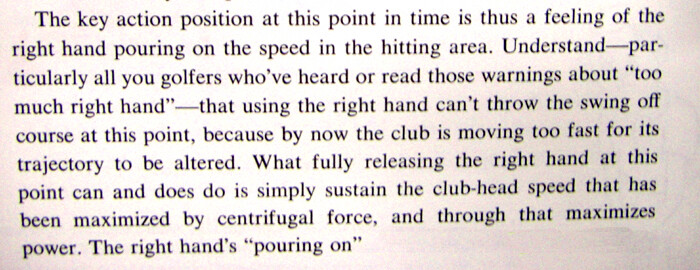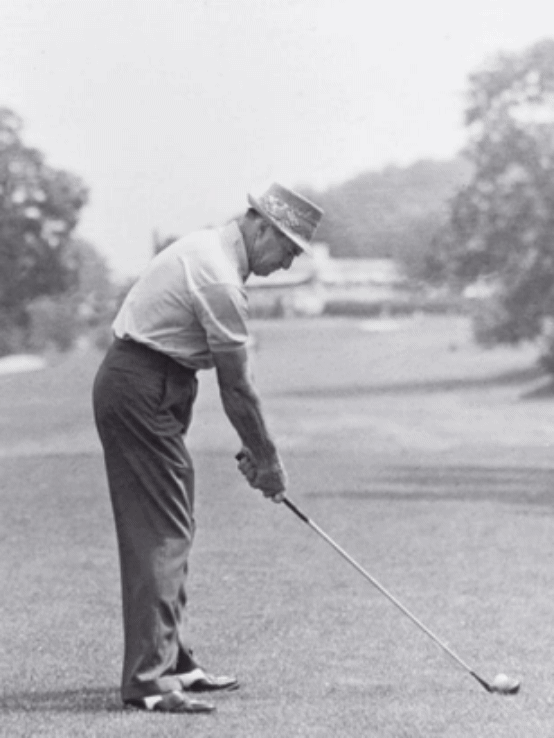Easily said, but maybe not so easily done or else we wouldn’t all start by blowing lag in the down swing, right?
This drawing confuses me though. The concept is solid, but is Sam saying in the drawing that the point in the swing in which you see the illustrated hand is when the right hand starts firing? Because I really would have guessed it would be the 5th or maybe 6th set of hands back from impact… that’s where I’ve worked so hard to start feeling like the right hand is going to town on the ball.
Ah… wait a second. Now I get it… the darker (or more filled in) the right hand is, the more Sam feels he is ‘pouring it on’. Now that makes sense. I missed that the first time around.
Yes similar principal of the depth of the shading showing the depth of pressures in Hogan’s 5 lessons I guess.
Cheers,
Arnie
In my opinion
Snead pulled it because the right hand worked down and flattened from hip high to hip high (and also Mac O’Grady did this and also had a similar CP fade pattern from what I can see of his 1980s stuff) this sends the face and clubhead up and in. And encourages a slightly over the top and out to in path to defend the ball going left. But it suggests a long left miss. Hogan comes from deeper and more laid off and has his right hand working over and on top, in comparison. It has to. Both have to have their respective club and wrist attitudes.
They both look and share being synchronised (don’t really like that word, sequencing is what happens) in terms of the main components are still in motion all at the same moment - hips, shoulders, knee and elbow flex, wrist motions, clubhead and clubface motions. Dissipating forces across several joints, some of which are not just hinges and therefore reducing stress on the body. No surprises they played until a ripe old age.
But also enabling them, especially Hogan, to release the whole works (unless deliberately trying to retard motion for a particular shot) and especially under pressure. Assuming a normal shot and a golfer using the right hand passively, aka automatic (TGM) or ‘swinging’ (ABS) well, the same forearm muscles are still contracting and relaxing in the same manner as in an active release, you just forfeit the additional power.
The issue is when people shut down or run out of range of motion in body components prematurely. Has to happen at some point in order to transfer energy (the kinetic ‘ripple’/chain) to the outer part of the ‘system’. Especially proximal body components. Then the distal takes over. Which at the wrists causes a closing of the clubface. Too much out of sync motion in the hands will flip the clubhead and close the face.
If you held off the clubhead and face and were all pivot the ball cannot go left. If you hold off the pivot and are all hands and clubhead the ball cannot go right. If you blend both, the ball can’t go too wide of straight.
In my opinion that’s why when Hogan says if you get the left hand in the correct attitude, and hit hard with both, and don’t let the left go to sleep, he wishes he had three (could have said three thousand) right hands. Because you’ve locked in the strike. He had more twist about the shaft rotation so gave himself more range of motion in the hands, rotationally, by adopting a weak grip and palm-finger left hand grip, bent open clubs, reminders at 5.30 etc. modern driver you have to have a more neutral hand action in terms of twisting about the clubshaft.
Anything other than hitting with the right hand at that point just places a drag on the clubhead.
The biggest insurance policy in order to correctly hit hard with the hands is a post impact pivot intention (and reality) and range of motion in the forearms.
So you have a choice… passively swinging the club and gain consistency as long as you don’t juice it under pressure, but forfeit yardage.
Or… actively hitting with the club, and gain the additional power and consistency, as long as you don’t ‘relax’.
I think both can be trained, the first requires you to relax under pressure the second requires you to be a bit keyed up and focused as a baseline state when playing or practising.
I remember an interview with Snead I saw at some point years ago where he talked about the right hand adding ‘the crackle at the bottom’ or some sort of description like that. I don’t know if I’m remembering it properly, but I always think of Rice Crispies, ‘snap, crackle, and pop’ when trying to remember it.
It reminds me of a Christy O’Connor Snr. line where he said ‘the speed is at the bottom’. He also said, when talking about the backswing, ‘it’s back, not up’, which I thought was very clever, though something you’d think should be obvious by the name!
Based on Hogan’s undeniably consistent and “around” release, I’ve started to consider what release actually means - maybe this is controversial or obvious, but I think subconsciously, consciously, visually, etc, Hogan’s “full release” was around (not down) and included the hands and forearms only. Said differently, the right upper arm need not throw, flip, extend, because it’s not included in the logic of his “release”. Therefore, use your right hand (forearm) aggressively- you have to from that superior open (let’s call it full loaded ;)) position.
Brilliant clarification here, nice one.
Reading your posts, you seem to have an appreciation for words and descriptions, very cool. I’ve often thought that the ‘open’ description used here isn’t all that helpful, or accurate.
Calling that position ‘square’ would be the way to go imo, or ‘ABS Square’. For me, the club is ‘alive’ in that position, it’s not open. If the face is closed on the way down, or the toe is ahead of the shaft, it’s hold and manipulate all day from there. It’s like square to square putting, disaster - and if it doesn’t work on that short a distance, it’s hardly going to work at 100mph.
It’s also curious, and I’ve talked about this stuff on here a long time ago, how open and closed, in the traditional sense, are different depending on what you’re talking about - if the shoulders are pointing right, they’re closed, but if the clubface is pointing right, it’s open.
That sort of stuff is chaos for the subconscious imo. Sqauring up a clubface with ‘closed’ shoulders and an ‘open’ clubface, it’s meltdown stuff for the brain.
Excellent observation and point made about “open”. As Johnny Miller would say, that’s “good stuff”.
I thought that too when first digging some stuff out of the dirt, but also thought maybe back swing could mean using the bigger muscles of the back for moving the club away, but anyway, I sort of finalized on it’s back to get up, not up to get back.
BTW, did you ever hear the cause of death for O’Connor Jr. I was looking into his instruction for a while and couldn’t seem to find out what happened. He was in a clinic video opening Mount Wolseley Golf Academy and there was a large visible lump adjacent to his left lat. Just curious is all, love the O’Connor boys, pure gems…
I don’t know, Double R, it was said that he died in his sleep, not sure beyond that. I haven’t seen that clinic, must look into it.
I often thought the death of his son had a terrible impact on him, as you can only imagine. When Christy Jnr. died I wondered if it was inevitable in some way, a broken heart maybe.




